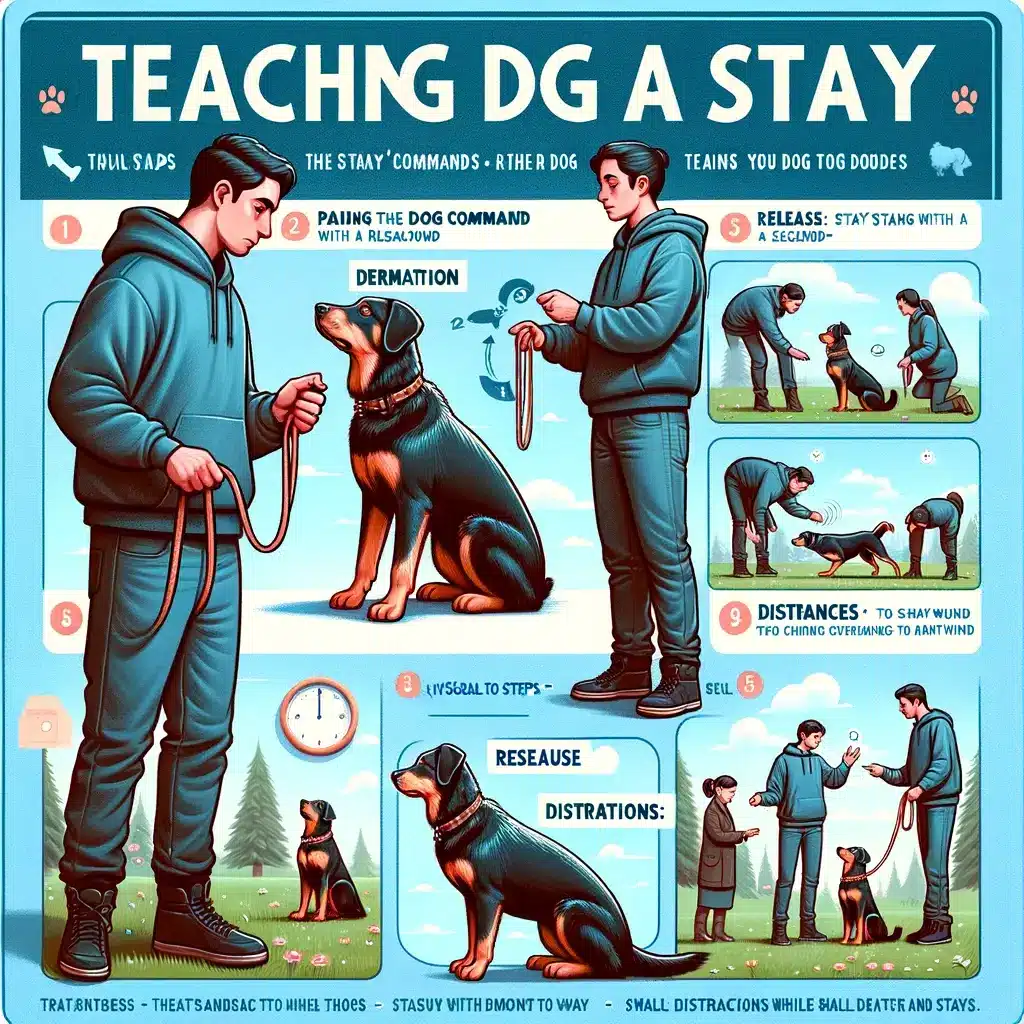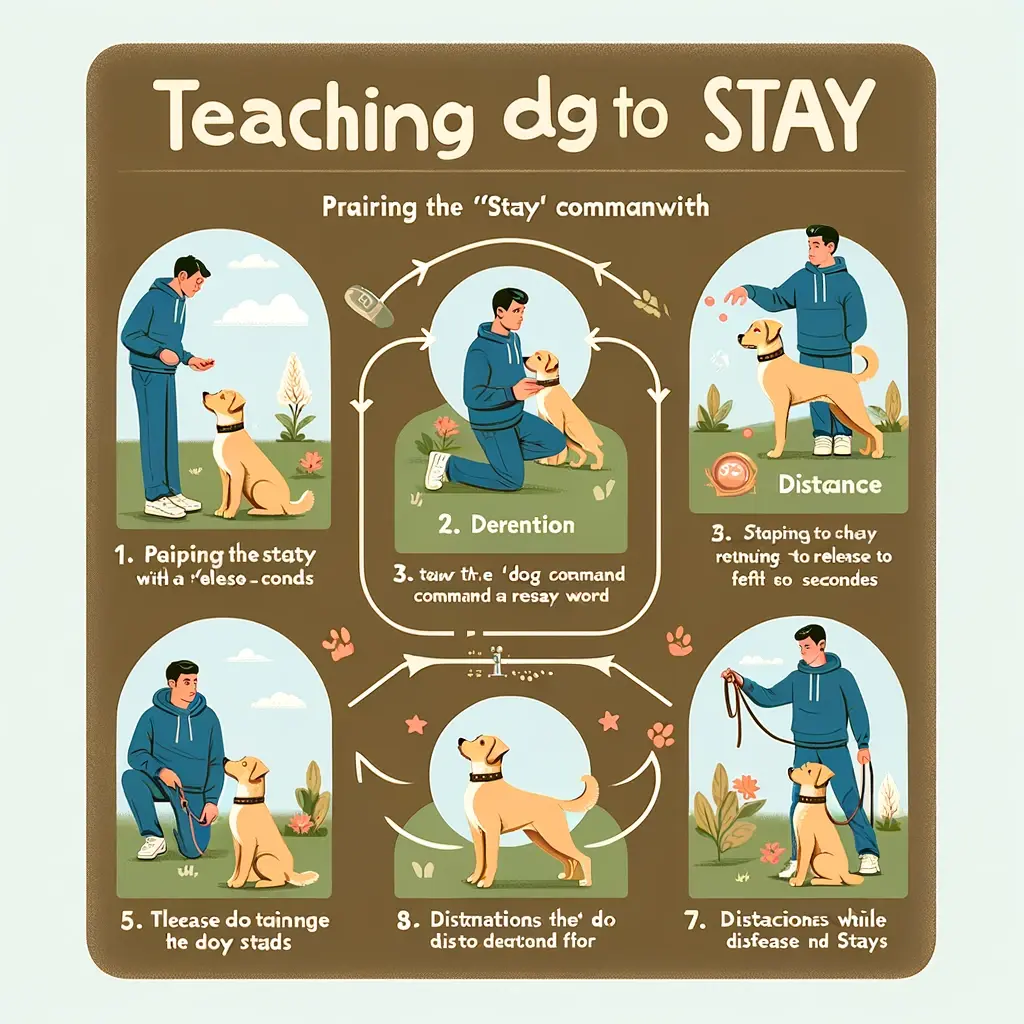How to Teach a Dog to Stay? – When you own a dog, it is necessary to teach them specific basic commands that they can obey. Training your dog to stay can be pretty simple and can also be used to keep your dog out of trouble.
Dogs can be enthusiastic, and in their eagerness to explore and have fun, they may fail to realize what dangers await them. By teaching them to stay, you can pause their actions and prevent them from getting into trouble.
You first need to practice the lying down command well before proceeding to ‘stay .’It is crucial that you gradually extend the time you want your dog to stay. You can increase the time by a few seconds or minutes each time.
Part of having a dog for a pet is teaching it obedience. One of the basic commands you will be teaching your dog is ‘stay. This is a way of controlling your dog’s actions.’ It can be used to keep your furry friend out of trouble.

How to Teach a Dog to Stay ?
One behavior considered a tad more difficult than others is commanding your dog to stay. This means teaching your dog to stay in several stages to stay and also leading the behavior in reverse, starting at the end and working backward for more extended stays.
Pair Release Words with ‘Stay’
Firstly you will have to pair your stay command with some release word that indicates that the stay is over. Some common release words are OK, accessible, and all done. You have to choose one of these words and use it consistently when the stay is finished.
To correctly teach your release word, position your dog in a way that you wish. This could be a sit, down, or stand. Then give your dog the stay command closely followed by the release command and the reward.
Dont fret if your dog doesn’t move post the release command. You can indicate in other ways, such as stepping back, clapping, or just positive interaction to signal that it is OK to move now.
Teach them the Three D’s
Once you have succeeded in pairing the stay command with a release word, you can move forward to teach your dog the three Ds.
Duration
This refers to the amount of time you want your dog to hold the staying position. First, position your dog as you wish. Give the stay command, and without moving, count to three. Then you can release your dog using the release word.
Increase the time for which he stays by seconds or minutes. In case your dog breaks this stay, release him and practice staying for a lesser duration.
Distance
Moving away from your dog is the distance phase. It is kind of normal for pet parents to rush this phase.
Position your dog as you wish and give him his stay command. Step back with one foot, lean back, then step back to your puppy and release him.
Next, take one step backward and return to your dog for release and reward.
Distractions
These are anything big or small that happens during your dog’s stay. Before you proceed further, include distractions and have a strong foundation with your release word, stay duration, and distance.
Start with something small like in your backyard etc., and then work your way up. Another good technique is to use high-value treats while introducing distractions.
Mistakes to Avoid While Teaching Your Dog
Do watch out for these issues when teaching to stay
- Do not give the stay command with food in your hand. Your dog will not obey and follow you.
- Do not constantly call your dog to come to you after a stay. Practice leaving your dog and then returning to them to give the release word.
What is the Technique of Proofing While Training Dogs?
Proofing is an essential part of training for reliability in various situations. Always start simple and move your way forward to what you’re asking your dog.
Proofing for Duration
No matter the proximity, dogs understand whether or not we are giving them our full attention. You can practice by asking your dog to stay as you sit, stand, lie down, watch Tv, etc. Never let your dog move before giving the release command.
Proofing for Distance
This means moving away from your dog and includes going out of sight. Practice this by moving away from your dog at various angles.
At the same time, work out of view using a mirror to see your dog around the corners. You can set him up angling a full-size mirror or use a hand mirror without his knowledge.
Proofing for Distractions
This is the slightly tricky part. Ways of distracting your dog include bouncing a ball, jumping up and down, or running past your dog.
In this method, you have to start slowly and build things that are of more interest to your dog. One hint is to use the command leave it during the stay.
Remember that if you feel your dog is going to move, repeat your stay command. Do what you think you need to do to help your dog be successful.
The more successful they are, the more reliable their staying behavior will be.
Steps to Follow for Teaching Your Dog to ‘Stay’
Whether you’re teaching a puppy to stay or training an adult dog, this step-by-step guide will work for sure.
Step 1: Choose Place
Choose a safe and quiet space when teaching your dog the stay command, especially when starting. Avoid any distractions—including sounds, movements, and scents. Etc
Step 2: Have Your Dog Sit
First, ask your dog to “Sit.” If you haven’t t already taught your pup to sit, postpone the stay command and teach it to sit first. If your dog isn’t sitting, it is almost impossible to get them to stay.
Step 3: Reward Your Dog
Once your dog sits, don’t reward them right away. Wait a few seconds, reward your dog with training treats, an enthusiastic response, or scratches, rubs, and pats—whatever makes your dog the happiest.
Step 4: Repeat this, But increase the Delay.
Ask your dog to sit again, but this time add a few more seconds before rewarding them. Do this several more times, each time increasing the Delay between the sit command and their reward by three to five seconds. You can work this way till you hit at least 15 seconds.
Step 5: Introduce the ‘Stay’ Command
Repeat the above steps until your dog can hold their sit for at least 15 seconds. At this time, you can begin using the dog stay command. Say, “sit,” and wait for them to sit, then say, “Stay.” Make sure to use a clear and confident voice, and always give your dog a treat to reward their obedience!
Step 6: Introduce the Release Command
Now it’s time to introduce the release command. Start by telling your dog to sit, then after 15 seconds, give your release command and toss some training treats so your pup must get up to receive them. A release command might be a hand signal—such as lifting your hand—or the words “OK” or “Go.”
Step 7: Make it More Challenging.
Once you know how to teach a dog to stay, you can up the ante. For example, you can add distance between you when giving the command or have them hold the stay command for longer.
Also, once your dog has a firm grasp of this cue, you can begin using it in everyday scenarios, like on walks.
Things to Avoid While Teaching Your Dog
Teaching a dog to stay requires lots of patience from both sides involved. Start with small bursts, reward your dog well, and remain positive. Here are a few things that you should avoid
Don’t Get Frustrated
If you find yourself losing patience, step back and try the next day again. Never try to rush the process.
Don’t Make them Stay for Long Periods
The stay command is meant to keep your dog out of trouble for relatively short periods. To foster meaningful trust between you and your pup, never use the stay command for extended periods of time.
Avoid Unsafe Situations
Only have your dog sit in safe situations. For example, they shouldn’t be left alone at a dog park or near a busy street.
How to Teach a Puppy to ‘Stay’?
A puppy who knows the “stay” cue will remain sitting until you ask him to get up by giving another signal called the “release word.” Staying in place is a duration behavior. The goal is to teach your pup to remain sitting until the release cue is given, then begin adding distance.
- First, teach the release word. Choose which word you will use, such as “OK” or “free.”
- Stand with your puppy in a sit or a stand, toss a treat on the floor, and say your word as he steps forward to get the treat.
- Repeat this a couple of times until you can say the word first, and then toss the treat AFTER he begins to move. This teaches the dog that the release cue means to move your feet.
- When your dog knows the release cue and how to sit on cue, put him in a sit, turn and face him, and give him a treat.
- Pause, give him another treat for staying in a seat, then release him.
- Gradually increase the time you wait between treats (it can help you sing the ABCs in your head and work your way up the alphabet).
- If your dog gets up before the release cue, that’s OK! It means it isn’t ready to sit for that long, so you can make it easier by going back to a shorter time.
- Once your dog can stay in a sit for several seconds, you can begin adding distance.
- Place him in a sit and say “stay,” take one step back, then step back to the pup, give a treat, and your release word.
- Continue building in steps, keeping it easy enough that your dog can stay successful. Practice facing him and walking away with your back turned (which is more realistic).
Once your dog can stay, you can gradually increase the distance. This is also true for the “sit.” The more solidly he learns it, the longer he can remain sitting.
The key is not to expect too much, too soon. Training goals are achieved in increments, so you may need to slow down and focus on one thing at a time. To ensure the training “sticks,” sessions should be short and successful.
Basic Puppy Training Tips
Let training sessions be short and fun. End each session positively with a delicious treat or lots of cuddles.
If you feel your dog is having difficulty learning or being “stubborn,” evaluate if you need to slow down and make the steps more accessible, or does your dog needs a bigger paycheck for a more strenuous exercise? If you and your puppy continue to work hard—and have fun—at training, You will surely see progress.
Teaching your dog to stay is one of the top skills to teach your dog to stay safe. Stay is helpful in many different situations, be it being able to look both ways before crossing a street while out for a walk or preventing door dashing when you have guests over.
It’s great to cue to practice your dog’s self-control, and, in some cases, it can encourage calming and relaxation.
Defining Your ‘Stay’ Criteria
When you teach your dog to stay, you must know precisely what you mean. The general definition of stay is for your dog to hold a stationary position until they are permitted to do otherwise. You can try making your dog stay for different time intervals.
Think about your criteria at the Duration, Distance, and Distraction levels. You can also check out the questions below to clear out your training doubts.
What position will you usually be asking your dog to stay in?
Often dogs are able to hold a longer duration of stay in a relaxed, down position.
How long will you typically need your dog to stay in that position?
This can differ from situation to situation. It’s long enough to grab their leash before you let them out of the car (about ten seconds) or while you eat dinner with the family (about 30 minutes).
How far away will you be from your dog when they hold their stay?
Walk to the front door and come back again. Or you can choose to move out of your dog’s sight in order to test their patience.
Where will you usually be asking your dog to stay?
It is recommended to train your dog at home where there are few distractions. Or while sitting at the corner cafe with people and other dogs passing by.








